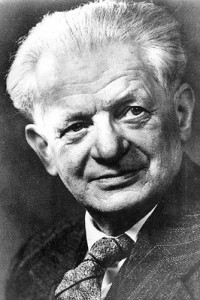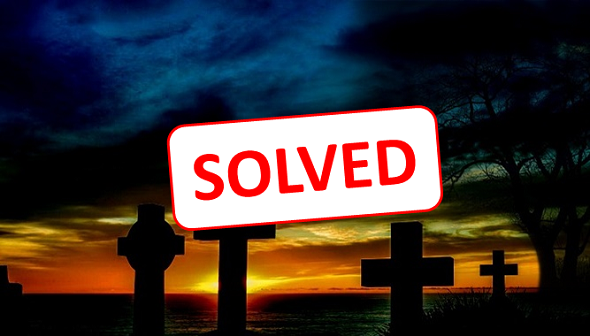Message B, a ciphertext left behind by British parapsychologist Robert Thouless, baffled codebreakers for over 70 years. Richard Bean from Brisbane, Australia, has now broken it.
The last few days have been among the most outstanding since I became intersted in cryptology. After I had the pleasure to report on three spectacular codebreaking successes within only one week, yesterday I learned about yet another thrilling cryptanalysis coup. Richard Bean, who recently solved the only unbroken IRA message from Jim Gillogly’s book Decoding the IRA, has deciphered another cryptogram that baffled experts for decades: Robert Thouless’ message B, also known as the second “cryptogram from the crypt”.

Richard Bean (used with permission)
Robert Thouless’ life-after-death experiments
Robert Thouless’ (1894-1984) main claim to fame is that he was the father of David Thouless, a condensed-matter physicist who won the Nobel Prize for physics in 2016. Robert Thouless worked a scientist, too, but his research interests differed considerably from the ones of his son. Thouless senior was a psychologist with a strong interest in parapsychological studies. Like all other people who conducted serious parapsychology research, he was not especially successful. Neither Thouless nor anybody else has ever succeeded in proving that things such as telepathy, telekinesis or precognition really exist.

Wikimedia Commons (Public Domain)
In 1948, Robert Thouless started his most famous experiment. He took a short text, encrypted it and published the ciphertext – while he kept the plaintext and the key secret. His plan was to channel the key from the beyond after his death. If somebody received the correct key via this psychic method, the cryptogram could be deciphered. This experiment, if successful, would prove that there is a life after death and that the dead can communicate with the living – certainly one of the greatest discoveries in the history of science.
To be on the safe side, Thouless published even two ciphertexts (message A and message B), encrypted in different systems. In case one of the challenges didn’t work (for instance, because the key got lost during Thouless’ after-death journey to the beyond), there was still a second one that could make the experiment a success.
However, after only a few weeks, Touless’ message A was solved by an unknown codebreaker – with cryptanalysis, not with psychic powers. This new situation caused Thouless to create a third cryptogram (message C) as a substitute for the solved one. When Robert Thouless died in 1984, he left behind the following three ciphertexts:
- Message A: This one is encrypted in a Playfair cipher. As mentioned, it was solved in 1948, soon after publication.
- Message B: The second message Thouless created is encrypted in a polyalphabetic cipher. It was unsolved until recently. It is listed at position 35 on my top 50 unsolved cryptograms page.
- Message C: This message is encrypted in a double Playfair cipher. In 1996 crypto experts Jim Gillogly and Larry Harnisch broke it with hill climbing. Again, it was not a psychic stunt that solved the message, but conventional codebreaking.
As far as I know, Thouless’ experiment did not prove successful – nobody has ever come up with a correct key he or she received from the beyond.
A few years after Thouless, his fellow psychic T. E. Wood from Bournemouth published a similar cryptogram, hoping he could some day send the key from the realm of the dead. Wood died decades ago, but his message is still unsolved – neither parapsychology nor cryptanalysis could break it.
Good overviews on Thouless’ and Wood’s experiments are available in my my book Nicht zu knacken (German) and Craig Bauer’s book Unsolved! (English).
Both books also mention a ciphertext I created myself in order to channel the key after my death (here’s a German blog post about it). Contrary to Thouless and Wood, I used a modern cipher, the AES, to encrypt my message. Perhaps, this will make the difference. I hope, the postmortal part of the expermient won’t start too soon.
Message B solved
After message A was solved in 1948 and message C in 1996, it lasted until August 2019, when there was news about message B having been broken. It was Richard Bean, an Australian codebreaker, who claimed this success and published the news as a comment on my blog. Here’s the plaintext he detected:
A number of successful experiments of this kind would give strong evidence for survival
It goes without saying that I was more than thrilled when I read Richard’s note. It is nothing unusual that somebody informs me that he or she has deciphered a famous cryptogram (usually, it’s the Voynich manuscript, other favorites are the Dorabella cryptogram and the fourth part of the Kryptos inscription), but in this case the note came from a successful cryptanalyst!
It didn’t take long before I saw that Richard’s solution was correct. What a success!
Before we take a look at the solution, I am going to introduce message B. The encryption system Thouless used is based on a sequence of words (taken from a book or some other published text) that is used as key. As an example, we take the following sentence:
TO BE OR NOT TO BE THAT IS THE QUESTION
As a first step, words that have already appeared earlier in the sequence (in this case, TO and BE) are eliminated. We get:
TO BE OR NOT THAT IS THE QUESTION
The next step is to convert each letter to a number (A=1, B=2, C=3,… Z=26):
20.15 2.5 15.18 14.15.20 20.8.1.20 9.19 20.8.5 17.21.5.19.20.9.15.14
Next, the numbers of each word are added. For example, the word NOT yields 14+15+20 = 49. If the result is larger than 26, it is reduced by 26 until a value between 1 and 26 is received. This means that NOT receives the number 23. We get:
9 7 7 23 23 2 7 16
In the next step, each number is added to the respective letter of the plaintext (again, if the result is larger than 26, it is reduced by 26). For the plaintext NEBRASKA we get:
Plaintext: N E B R A S K A Key: 9 7 7 23 23 2 7 16 Ciphertext: W L I O X U R Q
This means that NEBRASKA encrypts to WLIOXURQ.
The message Thouless encrypted with this method (message B) is the following:
INXPH CJKGM JIRPR FBCVY WYWES NOECN SCVHE GYRJQ
TEBJM TGXAT TWPNH CNYBC FNXPF LFXRV QWQL
It was always clear that this message clould only be solved if someone finds the text that was used as key – unless, of course, somebody received the key from the beyond.
How Richard solved it
After I had heard that Richard had broken Thouless’ message B, I asked him how he did it. Thankfully, he sent me a detailed report. Here it is:
I think I read about this cipher first in around 1995 when Jim Gillogly cracked the Playfair part of the cipher.
I started searching for the answer on 11 August – I thought that as I’d downloaded all of Project Gutenberg (about 37,000 books) to create my 6-gram statistics, I should write a program to search through all of it to extract all of the 74 word phrases (removing repeated words).
Then I could score the results using the 6-gram statistics. About 31,000 books through it (a few days), it came across Gutenberg book 41215, “Selected Poems of Francis Thompson“, and it found
-5309238 CEVHHZGMKLUCCESSFULEXPERIMENTSOFTNEKKIWTDXDAUGIVESTRVMGEVIDENCEFOROXRVIVAL THE HOUND HEAVEN I FLED HIM DOWN NIGHTS DAYS ARCHES YEARS LABYRINTHINE WAYS MY OWN MIND IN MIST TEARS HID FROM UNDER RUNNING LAUGHTER UP VISTAED HOPES SPED SHOT PRECIPITATED ADOWN TITANIC GLOOMS OF CHASMED FEARS STRONG FEET FOLLOWED AFTER BUT WITH UNHURRYING CHASE AND UNPERTURBED PACE DELIBERATE SPEED MAJESTIC INSTANCY THEY BEATAND VOICE BEAT MORE INSTANT THAN ALL THINGS BETRAY THEE WHO BETRAYEST ME PLEADED OUTLAWWISE BY MANY A HEARTED CASEMENT CURTAINED RED
which was a huge drop from the other two best solutions it had found:
-6137393 HUGFCEWLTGAGJPTJANNOXPERIMENTSOFTHISKIWTDXDAZVEBZTZVRVREPGQJVTUCFLXWBVRRDZ VOICE ROUND ME LIKE BURSTING SEA ILLUSTRATION OWN MIND THE HOUND HEAVEN I FLED NIGHTS DAYS ARCHES YEARS MIST TEARS FROM UNDER RUNNING LAUGHTER UP VISTAED HOPES SPED SHOT PRECIPITATED ADOWN TITANIC GLOOMS CHASMED FEARS THOSE STRONG FEET FOLLOWED AFTER BUT WITH UNHURRYING CHASE UNPERTURBED PACE DELIBERATE SPEED MAJESTIC INSTANCY BEATAND BEAT MORE INSTANT THAN ALL THINGS BETRAY THEE WHO BETRAYEST PLEADED OUT LAWWISE BY MANY HEARTED CASEMENT CURTAINED RED TRELLISED INTERTWINING CHARITIES FOR
-6099427 NOPKOLOKKOHFEIMTENYEUCZWCYEWUHMUFDDYSCARDINGREINASWIGGINORNMGBDKHIWDPDIMKZ BUY WELL I WANT THEM CAN GO YOUR WAY FAR CONCERNED THERE ONLY ONE THING FOR OFFER YOUTHE LADIES OF COURSE MEANFIVE THOUSAND FRANCS EACH FIVE MADAME MURMURED MADEMOISELLE FLOSSIE SAID NOTHING BUT HER EYES SHONE THE QUESTION MONSIEUR WHAT BECOME PHYLLIS POYNTON YOUNG ENGLISH LADY SEEMED NARROW A MOMENT LOUIS LIT CIGARETTE WITH FINGERS SHOOK LITTLE FAIR FACE WAS SUDDENLY WHITE THEN THEY ALL THREE LOOKED AT ANOTHER DO YOU KNOW WHOM MAY
Looking at it, I saw “UCCESSFULEXPERIMENTSOF” and “EVIDENCEFOR” and I knew I’d found it. A bit of adjustment fixing the text and I had got the right plaintext.
I did know the poem – there’s a fantastic reading of it by Richard Burton on YouTube. Richard Burton does much better than Richard Bean ever could!
Meanwhile, I am running out of words that do justice to my admiration of Richard and the other codebreakers who recently solved all these difficult cryptograms. Congratulations and thanks! I am proud to have so many great cryptanalysts among my readers.
Follow @KlausSchmeh
Further reading: Three crypto challenges created by master codebreaker Jim Gillogly
Linkedin: https://www.linkedin.com/groups/13501820
Facebook: https://www.facebook.com/groups/763282653806483/



Kommentare (2)